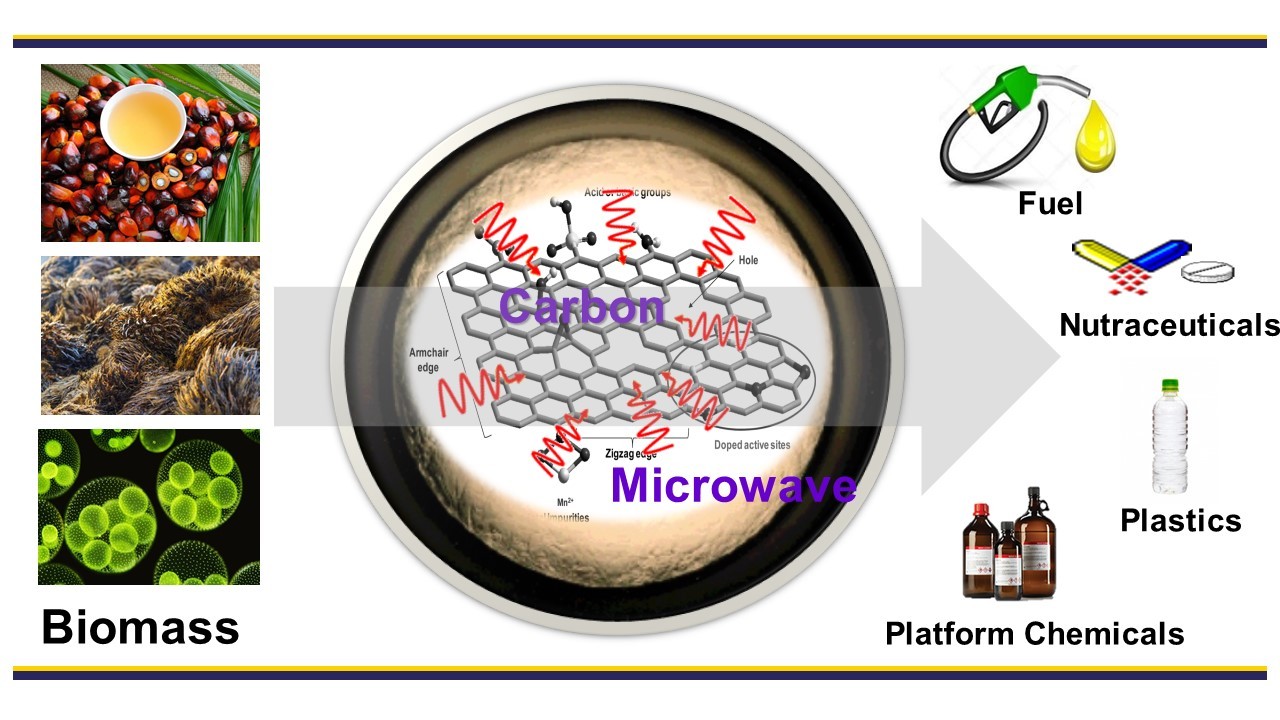Technologies
Discover, Connect & Collaborate at TECHINNOVATION 2021
Microwave-Carbon Catalysis for Biomass Valorisation
Technology Overview
Microwave accelerates reactions as it avoids pre-heating stage prevailing under conventional method. It also rotates materials based on polarity, thus providing effective interaction among many molecules. Carbon, a largely sustainable material, has a very strong affinity with microwave. Carbon-based catalysts can replace conventional harmful ones for biomass transformation reactions. They can be easily separated from the products and eliminates neutralisation, which are normally required in conventional catalysis. This significantly reduces reaction time and energy usage.
The research team offers know-how and technologies on the synergism of microwave and carbon-based catalysts applicable to many types of reactions related to biomass valorisation. They also have expertise on the design of catalysts for various applications.
The team is seeking collaborations with stakeholders from various industrial sectors such as those working on renewable energy, pharmaceuticals, nutraceuticals, etc. that are interested in sustainable green approaches to the utilisation of vast biomass resources in ASEAN region. They seek strong and sustainable partnerships to contribute to the realisation of Carbon Neutral 2050 and attainment of sustainable development goals (SDGs) by 2030 and beyond.
Technology Features, Specifications and Advantages
The features of the technology which make it more advantageous over other existing ones are as follows:
- Sustainable: It utilises clean microwave energy and carbon materials that can also be derived from natural resources.
- Green: No other toxic reagents are utilised, consequently eradicating the generation of wastewater for neutralisation and hazardous by-products. It can also replace the use of environmentally harmful metal-based catalysts.
- Energy efficient: Microwave eradicates barriers to energy transfer as heating originates from the system, thereby skipping the induction stage in conventional systems and accelerates the reaction.
- Environment friendly: Pre- and post-treatments are unnecessary. Carbon catalysts can be easily separated via ordinary filtration.
Hence, the technology utilising the synergism of microwave and carbon will provide an efficient, environmentally benign, and sustainable process for various applications, including conversion of biomass to useful biorefinery platform chemicals.
Potential Applications
Some possible applications of the technologies include, but not limited to:
- Conversion of land-based (e.g. oil palm, sugarcane bagasse) and marine-based biomass targeting natural biopolymers (e.g. lignin, lipids and protein) into biorefinery platform chemicals
- Conversion of microalgae into useful chemicals and fuels
- Development of nutraceuticals and pharmaceutical products
- Development of community-based efficient biofuel production methods especially in remote areas
- Green synthesis of fine chemicals
- Development of biodegradable plastic materials
Customer Benefit
- Microwave apparatuses are readily available and easy to commercialise; small laboratory scale apparatus can be multiplied to reach the same throughput with higher efficiency, avoiding rigors inherent in the conventional scaling-up procedures. For example, in a 100-ml reactor, fatty acids can be converted completely to esters in 3 min using this technique. Over 60% of cellulose can also be converted to more easily fermentable glucose in 1 hr.
- Can also be easily integrated in existing chemical production facilities like a refinery
- Uses clean and green microwave energy
- Utilisation of carbon has added benefits of mitigating global warming
- The technology being compact can be easily implemented even in remote community areas for biofuel production, thus contributing to regional revitalisation, realisation of carbon neutral society, and the attainment of sustainable development goals (SDGs)
- Highly suitable in ASEAN region, which is home to almost 1/3 of the world’s biomass potential

